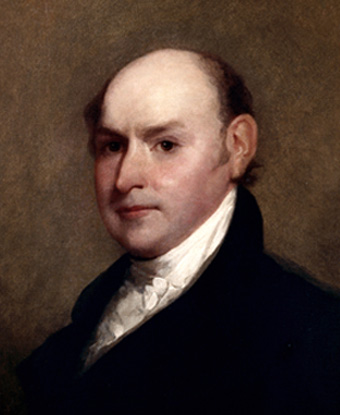Last updated: February 22, 2019
Person
John Quincy Adams

The White House Historical Association
No American was better prepared to be president than John Quincy Adams. He was the son of the second president of the United States, John Adams, and his mother, Abigail Adams, was a fervent revolutionary patriot in her own right. Through their example, he learned to value the sacrifices necessary to preserve and protect democracy, and the level-headed temperment required to be an effective leader.
As an 8 year-old Adams received letters from his father at the Continental Congress in Philadelphia, which reflected on the ongoing debate for independence. When war broke out, John Quincy and Abigail watched battles in the distance from a hill near their farm outside of Boston. These experiences made John Quincy Adams literally a child of the American Revolution: sharing a sense of destiny with the new nation, its consolidation, and its expansion.
At the age of 10, John Quincy traveled to France with his father, who was on a diplomatic mission to negotiate peace with Great Britain. There, John Quincy learned about international relations, became close with mentors Thomas Jefferson and Benjamin Franklin, and perfected his French by teaching English to the new French minister to the United States. His mother implored John Quincy to take great advantage of these opportunities, saying: "These are the times in which a genius would wish to live. It is not in the still calm of life, or the repose of a pacific station, that great characters are formed.... Great necessities call out great virtues." This opportunity to express “great virtue” finally presented itself in 1781.
Although only 14 years of age, Adams was sent to Russia as the private secretary and French interpreter for the U.S. Minister to Russia in 1781. Through this experience, he was able to pursue studies of history, science, and language, and participated in the negotiation of the Treaty of Paris that concluded the Revolutionary War. When he returned to Boston, Adams sought to become an attorney, and attended Harvard University. Adams claimed to be “a man of my whole country,” and indeed he was. Adams was appointed to a diplomatic position by each of the first five presidents of the United States – serving as the foreign Minister to the Netherlands, Prussia, Russia, and England, in addition to serving as a chief negotiator for the Treaty of Ghent, ending the War of 1812. At home, he served as Senator of Massachusetts, and as the Secretary of State under James Monroe.
Finally, in 1825, Adams had the opportunity to step into the position he had been grooming for since he was 14: President of the United States. The 1824 election was close, with Adams beating out the popular War of 1812 hero Andrew Jackson in a Congressional run-off. When John Quincy Adams assumed the presidency, he was surrounded by doubters and Jackson’s supporters dedicated to making his tenure difficult. Adams’ vision for the United States was broad and designed for long-term change. He advocated for a national university and naval academy to train future leaders, an extensive commerce system of canals and turnpikes to facilitate trade, a uniform system of weights and measures, and construction of an astronomical observatory to advance the field of science. Many of these proposals were greeted with scorn and derision, and seen as out-of-touch with the American people.
As his presidential term progressed, Adams continued to meet opposition from Jacksonian supporters. Adams refused to sign an Indian treaty which would have removed the Creeks from ancestral land in Georgia, but this concern for the rights of American Indians irritated both Southerners and Westerners alike. As Jackson’s supporters took control of both houses of Congress, it became apparent, even before the 1828 election, that like his farther, Adams would serve only one term as President.
Yet his political career did not stall. After his presidency, Adams served in the House of Representatives from 1831 until his death in 1848, becoming a tireless champion for the abolitionist cause. In 1839 he presented a constitutional amendment prohibiting any person born in the United States to ever be sold into slavery. After the slave rebellion aboard the ship Amistad, Adams successfully represented the slaves in an 1841 Supreme Court case and ensured their freedom and return to Africa. Adams’ last moments were spent, appropriately, in the U.S. Capitol. He suffered a stroke on February 21, 1848 on the floor of the House of Representatives arguing against the Mexican-American War and died two days later.
